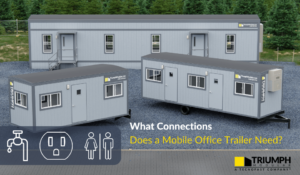As a brick-and-mortar business or organization, you never know when you’ll need additional space.
Whether it’s a school undergoing a major overhaul, a hospital expanding its facilities, or an office building in the midst of a renovation, having a versatile solution is crucial.
This is where the concept of “swing space” comes into play.
Among the many benefits of modular construction, providing businesses with a viable swing space solution is near the top.
Let’s explore the advantages of using modular construction for swing space. But first, what exactly is swing space?
What is Swing Space?
Swing space is a dynamic and versatile solution in the world of construction and facilities management. It acts as a temporary or transitional space that serves as a lifeline during critical periods of change, such as construction, renovation, or when a facility’s primary space is temporarily unavailable. The term “swing space” perfectly encapsulates its role – like a pendulum in motion, it allows organizations to smoothly transition between states of operation.
What Kind of Projects Benefit From Swing Space?
The beauty of swing space is that it can be used in so many different ways across nearly any industry.
Let’s look at a few examples:
Education
Picture a bustling university campus in the midst of a major renovation project. Classes must go on, administrative offices need to function, and student services must remain accessible.
In this scenario, swing space provides the university with the much-needed flexibility to maintain daily operations and services, ensuring that the continuity of education and other essential activities remains uninterrupted.
Healthcare
The medical field also makes use of swing space.
For example, let’s say a hospital that has decided to undergo a significant renovation of its emergency department. The goal is to modernize facilities, improve patient care areas, and implement the latest medical technologies.
However, the hospital needs to continue to provide emergency medical services and maintain patient care during the renovation process.
Here, swing space could take the form of a temporary modular medical facility located on or near the hospital premises. This space is carefully designed to replicate essential functions of the emergency department, including examination rooms, triage areas, and other critical medical services.
Retail and Other Businesses
Swing space is certainly not limited to government use — businesses operating in retail can make use of swing space during renovations or construction, too.
For example, a car dealership trying to create a more modern and inviting space to showcase the latest car models and cutting-edge automotive technology.
If the dealership wants to continue its sales operations, serve existing customers, and attract new ones during the renovation process, they’ll need to make use of swing space.
Here, swing space could be used to create a temporary showroom or display area adjacent to the main facility. This space is strategically designed to showcase a selection of popular cars, highlight key features, and provide a comfortable environment for potential buyers to explore the available options.
There are many more industries and use cases for swing space as well, including:
- Hospitality
- Manufacturing
- Technology
- Entertainment
- Agriculture
- And more
If your business is undergoing renovations and you need to continue operations, swing space can help.
Why Use Modular Construction for Swing Space?
So, what is it that makes modular construction such an attractive option for swing space projects?
Speed to Occupancy
In many cases, businesses and organizations need to pivot quickly to a new building when renovations or construction is happening.
When speed to occupancy is the primary issue, modular construction is the way to go.
The exceptional speed to occupancy provided by modular construction allows businesses to acquire their swing space in record time. The rapid assembly ensures a swift transition, minimizing downtime and swiftly meeting the immediate needs of the organization.
This accelerated timeline is especially important for projects requiring urgent deployment of swing space, such as emergency medical facilities or temporary classrooms needed for an upcoming school semester.
The key to this speed lies in the off-site construction process, where modular components are prefabricated in a controlled environment.
By preparing the elements away from the final location, delays associated with traditional construction, such as weather conditions and other variables, are significantly reduced.
Lower Site Impact
Since the majority of the modular construction process takes place in a controlled off-site environment, businesses will experience far less site impact. For example, minimizing noise levels, dust, and even the traffic disruptions caused by traditional construction.
For the education sector, this is especially important — it’s difficult for students to learn in a noisy construction environment!
Sustainability
As the commitment to sustainable building practices continues to grow over the years, using modular for swing space becomes even more important.
This is because the off-site nature of modular construction contributes to sustainability in several ways, including reduced material waste and precise resource utilization.
The lower site impact of modular construction also plays a role — with less equipment and time spent on site, emissions decrease, and so does the impact on the environment.
Cost Predictability
Renovations and building upgrades often come at a high cost. If possible, it’s best to choose a swing space option that provides cost predictability.
As long as design changes are kept to a minimum, the off-site building process of modular construction ensures cost predictability. While it’s not always the cheapest option, the streamlined construction process and lower site impact ensure that you won’t be surprised by a much higher cost compared to an original quote.
How Do You Furnish Swing Space?
Creating a functional and comfortable environment in swing space is essential for productivity and well-being — regardless of the industry.
Here are some tips for furnishing swing space. However, implementation of these tips may depend on your business and use case.
- Select Appropriate Furniture: Choose furniture that aligns with the intended use of the space. Consider comfort, ergonomics, and durability. Modular furniture can be a great choice, as it can be easily reconfigured to accommodate changing needs.
- Maintain Aesthetics: Don’t underestimate the power of aesthetics. A well-designed swing space can boost morale and productivity. Use color, lighting, and decor to create an inviting atmosphere.
- Accessibility: Ensure the swing space is accessible to all users, including individuals with disabilities. This includes accessible furniture, pathways, and restroom facilities.
Depending on the modular provider you choose, you may have some furniture package options to choose from.
For example, Triumph Modular offers The Solutions — a collection of furniture packages that you can choose from based on your needs. The Solutions range from bare necessities and basics to higher luxury packages.
Create Your Disaster Recovery Plan
Did you know swing space can work well in the event of a disaster?
To understand what you need to do with swing space in the event of a disaster, you need to be prepared. Our Disaster Recovery Checklist removes the guesswork and ensures that you know what to do before, during, and after disaster strikes.
It also allows you to keep track of the steps you’ve completed to ensure that you have a well-rounded and thought-out disaster relief plan.
Download the Disaster Recovery Checklist today!





